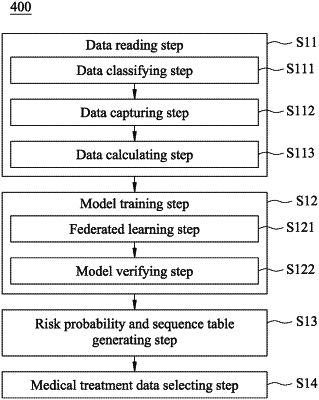| CPC A61B 5/201 (2013.01) [A61B 5/7267 (2013.01); A61B 5/7275 (2013.01); G16H 50/20 (2018.01)] | 8 Claims |

|
1. An acute kidney injury predicting system, which is configured to predict an acute kidney injury characteristic risk probability corresponding to a plurality of data to be tested conforming to an acute kidney injury characteristic, and the acute kidney injury predicting system comprising:
a main memory storing the data to be tested, a plurality of detection data, a machine learning algorithm and a risk probability comparison table, wherein the risk probability comparison table comprises a plurality of medical treatment data; and
a processor connected to the main memory and configured to implement an acute kidney injury predicting method comprising:
performing a data reading step, wherein the data reading step comprises reading the data to be tested, the detection data, the machine learning algorithm and the risk probability comparison table;
performing a model training step to train an acute kidney injury prediction model by using the detection data according to the machine learning algorithm;
performing a risk probability and sequence table generating step to input the data to be tested into the acute kidney injury prediction model to generate the acute kidney injury characteristic risk probability and a data sequence table, wherein the data sequence table lists the data to be tested in sequence according to a proportion of each of the data to be tested in the acute kidney injury characteristic; and
performing a medical treatment data selecting step to select one of the medical treatment data from the risk probability comparison table according to the acute kidney injury characteristic risk probability;
wherein the data reading step further comprises:
performing a data classifying step to drive the processor to classify the detection data into an acute kidney injury detection data group and a non-acute kidney injury detection data group according to an acute kidney injury standard, wherein the acute kidney injury detection data group comprises a plurality of vital signs data, a plurality of medication data and a plurality of blood inspection data;
wherein the vital signs data of the acute kidney injury detection data group are collected every minute in a time period between a patient entering to an intensive care unit and the patient leaving the intensive care unit, the time period comprises a data setting interval, a feature window interval and an early prediction interval, the feature window interval is located between the data setting interval and the early prediction interval, each of the vital signs data of the acute kidney injury detection data group has a timestamp, and the data reading step further comprises:
performing a data capturing step to drive the processor to capture the vital signs data of the acute kidney injury detection data group whose timestamps are located in the feature window interval; and
performing a data calculating step to drive the processor to calculate the vital signs data of the acute kidney injury detection data group whose the timestamps are located in the feature window interval to generate an average value and a variation value;
wherein in the model training step, the processor trains the acute kidney injury prediction model by using the average value, the variation value, the medication data and the blood inspection data of the acute kidney injury detection data group and the non-acute kidney injury detection data group according to the machine learning;
wherein the machine learning algorithm is an eXtreme Gradient Boosting (XGBoost).
|